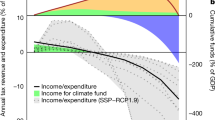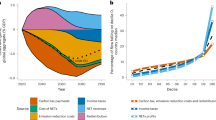Abstract
Carbon markets are considered a key policy tool to achieve cost-effective climate mitigation1,2. Project-based carbon market mechanisms allow private sector entities to earn tradable emissions reduction credits from mitigation projects. The environmental integrity of project-based mechanisms has been subject to controversial debate and extensive research1,3,4,5,6,7,8,9, in particular for projects abating industrial waste gases with a high global warming potential (GWP). For such projects, revenues from credits can significantly exceed abatement costs, creating perverse incentives to increase production or generation of waste gases as a means to increase credit revenues from waste gas abatement10,11,12,13,14. Here we show that all projects abating HFC-23 and SF6 under the Kyoto Protocol’s Joint Implementation mechanism in Russia increased waste gas generation to unprecedented levels once they could generate credits from producing more waste gas. Our results suggest that perverse incentives can substantially undermine the environmental integrity of project-based mechanisms and that adequate regulatory oversight is crucial. Our findings are critical for mechanisms in both national jurisdictions and under international agreements.
This is a preview of subscription content, access via your institution
Access options
Subscribe to this journal
Receive 12 print issues and online access
$209.00 per year
only $17.42 per issue
Buy this article
- Purchase on Springer Link
- Instant access to full article PDF
Prices may be subject to local taxes which are calculated during checkout


Similar content being viewed by others
References
IPCC Climate Change 2014: Mitigation of Climate Change (eds Edenhofer, O. et al.) (Cambridge Univ. Press, 2014); http://www.ipcc.ch/report/ar5/wg3
State and Trends of Carbon Pricing 2014 (World Bank, 2014); http://www-wds.worldbank.org/external/default/WDSContentServer/WDSP/IB/2014/05/27/000456286_20140527095323/Rendered/PDF/882840AR0REPLA00EPI2102680Box385232.pdf
Climate Change, Carbon Markets and the CDM: A Call to Action. Report of the High-Level Panel on the CDM Policy Dialogue (CDM Policy Dialogue, 2012); http://www.cdmpolicydialogue.org/report/rpt110912.pdf
Schneider, L. Assessing the additionality of CDM projects: Practical experiences and lessons learned. Clim. Policy 9, 242–254 (2009).
Ruthner, L. et al. Study on the Integrity of the Clean Development Mechanism (CDM) (AEA Technology, 2011); http://ec.europa.eu/clima/policies/ets/linking/docs/final_report_en.pdf
Schiermeier, Q. Clean-energy credits tarnished. Nature 477, 517–518 (2011).
Gillenwater, M. & Seres, S. The Clean Development Mechanism: A review of the first international offset programme. Greenhouse Gas Meas. Manage. 1, 179–203 (2011).
Spalding-Fecher, R. et al. Assessing the Impact of the Clean Development Mechanism (High Level Panel on the CDM Policy Dialogue, 2012); http://www.cdmpolicydialogue.org/research/1030_impact.pdf
Hayashi, D. & Michaelowa, A. Standardization of baseline and additionality determination under the CDM. Clim. Policy 13, 191–209 (2013).
Issues Arising from the Implementation of Potential Project Activities under the Clean Development Mechanism: The Case of Incineration of HFC-23 Waste Streams from HCFC-22 Production (United Nations Framework Convention on Climate Change, 2005); http://unfccc.int/resource/docs/2005/tp/eng/01.pdf
Wartmann, S., Hofman, Y. & de Jager, D. Instrumentation of HFC-23 Emission Reduction from the Production of HCFC-22. Assessment of Options for New Installations (Ecofys, 2006); http://unfccc.int/resource/docs/2006/smsn/ngo/021.pdf
Report of the Task Force on HCFC Issues (with Particular Focus on the Impact of the Clean Development Mechanism) and Emission Reduction Benefits Arising from Earlier HCFC Phase-out and Other Practical Measures (United Nations Environment Programme, 2007); http://ozone.unep.org/Assessment_Panels/TEAP/Reports/TEAP_Reports/TEAP-TaskForce-HCFC-Aug2007.pdf
Schneider, L. Perverse incentives under the Clean Development Mechanism (CDM): An evaluation of HFC-23 destruction projects. Clim. Policy 11, 851–864 (2011).
Note on the Revision of AM0001 (United Nations Framework Convention on Climate Change, 2011); https://cdm.unfccc.int/Panels/meth/meeting/11/049/mp49_an13.pdf
Rahman, S. & Kirkman, G. Costs of certified emission reductions under the Clean Development Mechanism of the Kyoto Protocol. Energy Econ. 47, 129–141 (2015).
CDM/JI Pipeline Analysis and Database (United Nations Environment Programme Danish Technical University Partnership, 2015); http://www.cdmpipeline.org
Schneider, L., Lazarus, M. & Kollmuss, A. Industrial Gas Projects Under The CDM: Adipic Acid—A Case of Carbon Leakage? (Stockholm Environment Institute, 2010); http://www.sei-international.org/mediamanager/documents/Publications/Climate/sei-adipicacidleakage-9oct2010.pdf
Information Note on AM0028: Catalytic N2O Destruction in the Tail Gas of Nitric Acid or Caprolactam Production Plants and AM0034: Catalytic Reduction of N2O inside the Ammonia Burner of Nitric Acid Plants (United Nations Framework Convention on Climate Change, 2012); https://cdm.unfccc.int/Panels/meth/meeting/12/058/mp58_an17.pdf
McCulloch, A. & Lindley, A. Global emissions of HFC-23 estimated to year 2015. Atmos. Environ. 41, 1560–1566 (2007).
2006 IPCC Guidelines for National Greenhouse Gas Inventories (Intergovernmental Panel on Climate Change, 2006); http://www.ipcc-nggip.iges.or.jp/public/2006gl
Common Reporting Format Tables Submitted to the UNFCCC (Government of the Russian Federation, 2014); http://unfccc.int/national_reports/annex_i_ghg_inventories/national_inventories_submissions/items/7383.php
COMMISSION REGULATION (EU) No 550/2011 of 7 June 2011 on Determining, Pursuant to Directive 2003/87/EC of the European Parliament and of the Council, Certain Restrictions Applicable to the Use of International Credits from Projects Involving Industrial Gases (European Commission, 2011); http://eur-lex.europa.eu/LexUriServ/LexUriServ.do?uri=OJ:L:2011:149:0001:0003:EN:PDF
Acknowledgements
We would like to thank K. Anttonen, O. Baskov, A. Friedrich, H. Laurikka, M. Lazarus, L. Mortier and V. Zhezherin for helpful input and comments. The research was prepared as part of a larger research project evaluating the environmental integrity of Joint Implementation, commissioned by the Austrian Federal Ministry of Agriculture, Forestry, Environment and Water Management, the Ministry of the Environment of Finland, and the Federal Office of the Environment of Switzerland. Any views expressed are those of the authors and do not necessarily reflect the official views of the Austrian, Finnish and Swiss governments. The research team bears sole responsibility for the content.
Author information
Authors and Affiliations
Contributions
L.S. evaluated the data and analysed the results. L.S. and A.K. wrote the paper.
Corresponding author
Ethics declarations
Competing interests
L.S. is member of the CDM Executive Board under the Kyoto Protocol.
Supplementary information
Rights and permissions
About this article
Cite this article
Schneider, L., Kollmuss, A. Perverse effects of carbon markets on HFC-23 and SF6 abatement projects in Russia. Nature Clim Change 5, 1061–1063 (2015). https://doi.org/10.1038/nclimate2772
Received:
Accepted:
Published:
Issue Date:
DOI: https://doi.org/10.1038/nclimate2772
This article is cited by
-
The International Dimension of the EU Emissions Trading System: Bringing the Pieces Together
Environmental and Resource Economics (2022)
-
Defining and Conceptualizing Impact Investing: Attractive Nuisance or Catalyst?
Journal of Business Ethics (2022)
-
Carbon-credit scheme linked to increased greenhouse-gas production
Nature (2015)



